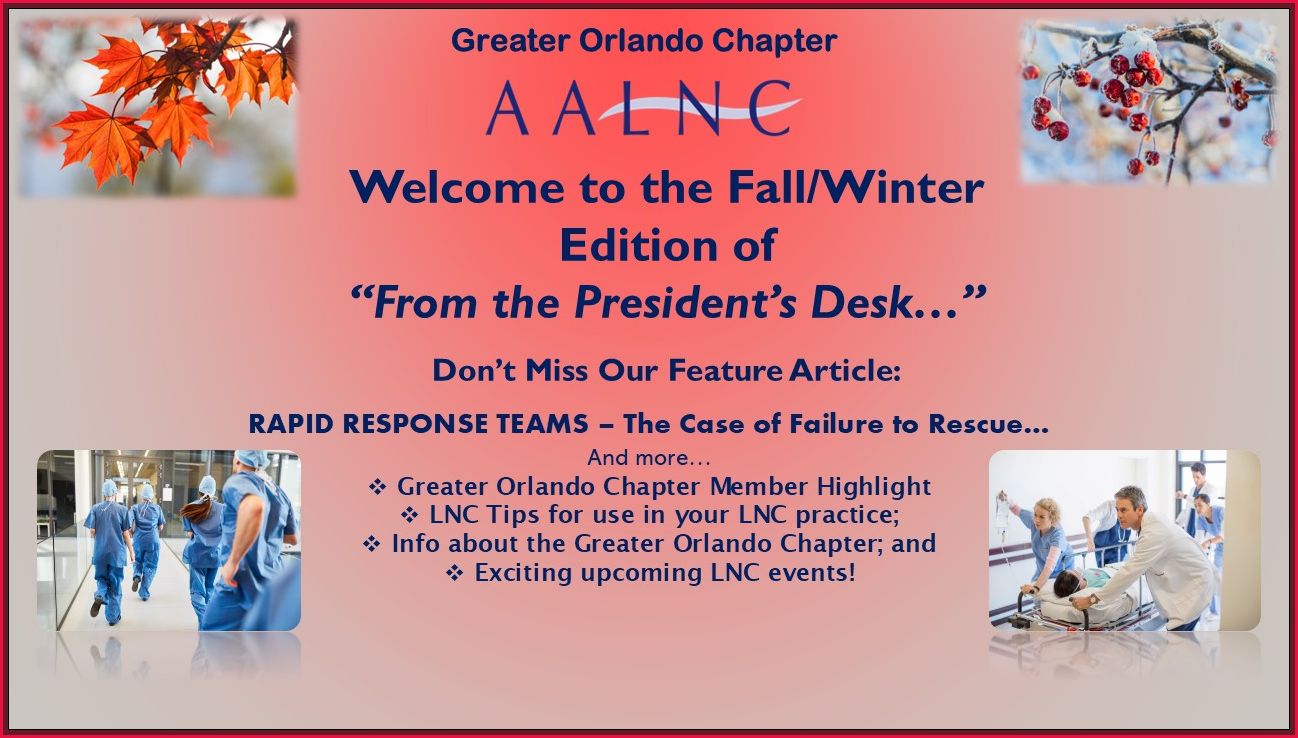
Rapid Response Teams:
The Case of Failure to Rescue
by
Christine Dorman, DNP, APRN, ACNP-BC, CCRN Vantage Point Legal Nurse Consulting, LLC
(Sources for this article are included in the Sidebar.)
Introduction
The development of cardiac arrest (code blue) teams has been well-established and commonplace in the United States (US) and international hospitals. However, studies have shown that the survival rate of adults experiencing cardiopulmonary deterioration that led to in-hospital deaths remains significantly high in the US (5).
Furthermore, prior research revealed that early warning signs (EWS) are often precursors to clinical deterioration that can lead to cardiac arrest. These studies demonstrated that patients typically experience signs and symptoms of clinical deterioration 6 to 8 hours prior to a code event (2). Likewise, the studies highlighted how EWS tools were utilized as a single scoring system embedded into the electronic medical record (EMR) to identify at-risk patients. This divulged fewer associated in-hospital cardiac arrests due to the combination of EWS tools and a clinician’s judgment when the rapid response system was activated (8).
Background
Can delaying or not activating the rapid response team (RRT) lead to failure to rescue (FTR) patients? To answer this question, it’s important to explore the history of RRTs and their emerging role in addressing FTR events in hospitals.
Rapid response teams: Rapid response systems (RRS) or RRTs were first introduced in Australia and adopted in the US in 2002 as a patient safety intervention (6). The concept of an RRT is to treat patients who demonstrate imminent signs of clinical decompensation. RRT is defined as a multidisciplinary group of hospital personnel who are deployed to respond promptly to acutely deteriorating patients outside of the intensive care units (ICU) (5).
Failure to rescue: FTRs are patient safety issues that arise from delay in recognition or response to an in-hospital complication(s). FTRs have been deemed a metric tool utilized by hospitals to access morbidity and mortality or simply put, an indicator of failed surveillance (7).
Development: Survival rates after in-hospital cardiac arrest is estimated between 7-26% (5). The culmination of these cardiac arrests, adverse events, and FTRs ultimately led to the development of RRTs (5).
Since 2004, RRTs have been widely adopted by hospital systems nationally and internationally, largely as part of the 100,000 Lives Campaign conducted by the Institute of Health (IHI). Consequential, The Joint Commission (TJC) mandated that all hospitals in the US establish a RRS as a part of the 2008 National Patient Safety Goal initiative. Additionally, in 2015 the American Heart Association (AHA) included RRS as a part of their guidelines for cardiopulmonary resuscitation and emergency cardiovascular care (8). Hence, the Agency for Healthcare Research and Quality (AHRQ) and TJC have endorsed both RRTs as patient safety practice and quality initiatives to reduce FTRs (1,5).
Team Composition
The team composition of RRTs will vary from institution to institution. Nevertheless, they exist to deploy the appropriate staffing resources to assess individual patients experiencing clinical deterioration. The main goal of the RRT is to intervene early to prevent further patient decline, cardiopulmonary arrest, and/or death. Early intervention ensures that proper triage, medical decision making, evaluation, testing (labs and/or imaging), medications, and care coordination is implemented in a timely fashion (2).
Typical makeup of RRT team members include physicians (hospitalist or intensivist) or licensed independent providers such as an advance practiced registered nurse (APRN) or physician assistant (PA), ICU nurse, respiratory therapists, and pharmacists (2).
Rapid Response Criteria
Patient monitoring and trends occur in a variety of formats. It ranges from surveillance of a patient’s heart rate, blood pressure, respiratory rate, pulse oximetry, capnography, urinary output, level of consciousness, and pain assessment. Any alteration in these monitoring trends is considered an EWS to prompt an RRT.
Preliminary research showed that delay or not activating an RRT in patients who meet the criteria can result in prolonged hospitalization and increased mortality (7). Any staff member can activate an RRT if there is a patient concern or if the criteria are met. In some hospitals family members are allowed to activate an RRT (7).
The most common criteria for activation of RRTs include:
- Airway compromise (threatened airway, pulse oximetry less than 90% despite oxygen supplementation);
- Acute change in respiratory rate (rate less than 8 per minute or greater than 28 per minute);
- Acute change in heart rate or cardiac status (rate less than 40 per minute or greater than 140 per minute);
- Chest pain unrelieved by nitroglycerin;
- Acute change in blood pressure (systolic pressure less than 90 mm Hg or greater than 180 mm Hg);
- Acute mental status change (unresponsiveness, seizures, hypoglycemia);
- Change in urinary output (less than 50 mL over 4 hours or no output); and
- Uncontrolled pain (2).
Effectiveness of Rapid Response Teams
Early publications reported substantial improvement in clinical outcomes. However subsequent studies remain controversial. Despite the controversy surrounding the benefits of RRTs, they exist nonetheless to address the potential benefits of early rescue therapy utilization, fostering quality care, and a culture of patient safety. RRTs are also a proposed standard of care (SOC) and safety practice endorsed by TJC and the IHI Quality to address FTRs (2,4).
Barriers to Implementation
Various factors affect barriers to effective RRT implementation. They include:
- A lack of understanding or recognition of the patient’s condition and deterioration;
- Nursing education;
- Limited nursing experience;
- Alarm fatigue;
- A lack of confidence in assessment skills;
- A lack of leadership support;
- A lack of staff buy-in due to poor organizational culture;
- Time of day;
- Poor staff workflow; and
- The burden of now caring for a more critically ill patient (5, 6).
Case Scenario
Mrs. MB is a 69-year-old female with a past medical history of asthma, hypertension, and hyperlipidemia who presented to the emergency room with a two-day complaint of difficulty breathing, cough, and wheezing. She is admitted to the telemetry unit for asthma exacerbation. Mrs. MB informs her nurse that she’s feeling a little anxious, shorter of breath, and requested medication to calm down. Over the next 24 hours she developed worsening hypoxia, tachycardia, and tachypnea. The next morning, Mrs. MB is found unresponsive with agonal respirations. Arterial blood gas revealed evidence of hypercarbia and hypoxemia. She’s immediately transferred to the ICU and intubated upon arrival.
The Role of the Legal Nurse Consultant
The duties of RRT respondents involve quick assessment and stabilization of acutely ill patients. A stepwise RRT approach is utilized in nearly all healthcare systems. This stepwise approach regarding responsibilities and proper monitoring is outlined in their facility’s policies and procedures. Many organizations incorporate trends and screening tools such as an EWS or modified early warning signs (MEWS) which are integrated into the electronic medical record (EMR). These are key factors that LNCs should recognize as they are indicative of a patient’s clinical deterioration (6,8,9).
Common Nursing and Medical Malpractice Litigation Themes
Duty: If a licensed provider or hospital employee fails to activate an RRT when a patient exhibits signs of deterioration may be viewed as a deviation in the SOC.
Breach: Nursing staff and healthcare providers have a duty to monitor patients and respond in a timely manner to those displaying a clinical change in condition. Failure to respond or activate RRTs may be viewed as a breach of duty.
Causation: If a hospital employee or healthcare provider’s delay or failure to activate RRT resulted in an adverse event or preventable patient outcome. This may help to establish causation.
Damages: Refers to the actual harm or injury sustained by the patient due to a medical professional’s negligence that results in hardship, loss of income, pain, disability, or suffering.
Some common nursing malpractice themes associated with potential rescue failures include but are not limited to:
- Failure to recognize signs of clinical deterioration;
- Failure to report a change in patient condition;
- Failure to monitor or document monitoring;
- Failure to communicate pertinent information;
- Delay or failure to activate RRT;
- Failure to follow institutional policies and procedures; and
- Inappropriate communication or documentation (3).
Some potential medical malpractice claims include but not limited to:
- Delay or failure to respond to an RRT;
- Failure to treat in a timely manner;
- Failure to provide correct treatment; and
- Failure to document RRT event (3).
Legal Nurse Consultant’s Case Scenario Review
In the above clinical scenario, the LNC’s medical record review discovered the following:
- The nurse missed the EWS or MEWS;
- The nurse failed to recognize a change in this patient’s condition;
- The nurse failed to activate an RRT;
- The nurse failed to communicate change in the patient’s condition to the provider; and
- The nurse failed to follow institutional policies and procedures
Summary
In conclusion, while research has shown some controversy on the effectiveness of RRTs and FTRs, it has addressed the importance of identifying preventable adverse outcomes that jeopardizes patient safety and quality care. Together these structured and standardized criteria help to reduce and/or eliminate adverse patient outcomes for non-ICU patients with treatable events.
RRTs have been cited as a National Patient Safety Goal by the TJC and AHRQ. It is has become the de facto SOC in hospitals throughout the US and worldwide. Prompt recognition and interventions are highly dependent on the staff’s skill set, competency, and experience. Reduced vigilance, lack of a multi-disciplinary team approach, and failure to initiate or follow RRT policies to reduce adverse events can predispose hospitals and their staff to potential liability.
(Sources for this article are included in the Side Bar.)
Author: Christine Dorman, DNP, APRN, ACNP-BC, CCRN
Greater Orlando AALNC Chapter, Director at Large
Owner: Vantage Point Legal Nurse Consulting
Website: https://vplnc.com
Email: christinedorman@vplnc.com
Contact: 800-368-7410
__________________________________________________________________________________
CHAPTER MEMBER HIGHLIGHT
CRYSTAL CRAWFORD, BSN, RN, RNC-LR, C-EFM

Crystal is an accomplished Registered Nurse with over 23 years of experience at the bedside. She has dedicated her entire career to maternal and newborn health in the areas of Labor & Delivery, High-Risk Antepartum, Mother/Infant and the Neonatal Intensive Care Unit. Since 2018, Crystal has assumed the role of managing the Neonatal Resuscitation Program at her current facility as well as practicing as an instructor and instructor mentor, contributing significantly to the professional development of healthcare practitioners in emergency newborn care. Her commitment to excellence is underscored by certifications in electronic fetal monitoring and low-risk neonatal nursing, reflecting her unwavering dedication to maintaining the highest standards of patient care. In addition to her clinical accomplishments, Crystal has cultivated a distinguished reputation as a legal nurse consultant and a sought-after nurse expert witness. Actively engaged with the American Association of Legal Nurse Consultants, she not only upholds professional standards but also serves as a Special Interest Group (SIG) chair, demonstrating leadership and commitment to advancing the field.
_______________________________________________________________________________

LNC PROFESSIONAL DEVELOPMENT
AALNC and Chapters – GoTo Source
AALNC and the Chapters are THE GO TO sources for networking and professional development in the field of legal nurse consulting. Want to learn of career opportunities? Want to stay up to date with the LNC industry trends? Want to hone your LNC skills and learn new ones? Then go to AALNC at https://aalnc.org and join now! Then go to https://orlandoaalnc.org and join our Chapter! And you can join ALL of the AALNC Chapters – for unlimited networking!
WE ARE NEAR YOU! Maybe not geographically, but through your computer or phone. The Greater Orlando Chapter has members in 30 States, Puerto Rico, and Canada! SINCE 2014, The Greater Orlando Chapter’s live Chapter Meetings with CE Programs have been broadcast virtually! Members and guests have been attending from all over the Country since then! Because of COVID, since 2020 all of our CE Programs have been virtual only.
Greater Orlando Chapter Membership Cycle goes from May to May of each year, with membership renewal being May 31. With this cycle, members who joined in 2024, will renew their membership NLT May 31, 2025. CONTACT US:
Email us at: info@orlandoaalnc.org
Or visit us at: https://orlandoaalnc.org
______________________________________

ABOUT THE GREATER ORLANDO CHAPTER OF AALNC
The American Association of Legal Nurse Consultants (AALNC) was founded in 1989, as a not for profit membership organization dedicated to the professional enhancement and growth of registered nurses practicing in the specialty of legal nurse consulting. Chapter development quickly followed. The Orlando community was rich with nurses already practicing in the field of legal nursing. This group of committed professionals quickly became members of the new national organization and recognized the need for a local chapter. The Greater Orlando Chapter of AALNC, founded in 1989, was the second chapter formed under the new national organization. The Chapter was begun in support of AALNC’s mission, by providing networking opportunities, mentoring and support to nurses through professional development and education – a mission that is continued to this day.
CONNECT WITH US
Connect with us on LinkedIn
Check us out at: https://orlandoaalnc.org
Contact us at: info@orlandoaalnc.org
1. Agency for Healthcare Research and Quality (AHRQ). (2019). Rapid response systems. Retrieved from https://psnet.ahrq.gov/primer/rapid-response-systems
2. Aliyeva, G.D. (2022). Rapid response situations: Management in adult and geriatric hospitalist medicine. Philadelphia, PA: Elsevier.
3. Dickinson, J. & Meyer, A. (2020). Legal nurse consulting principles and practices, 4th ed. New York, NY: Routledge.
4. Fischer, C.P., Bilimoria, K.Y., Ghaferi, A.A. (2020). Rapid response teams as a patient safety practice for failure to rescue. JAMA, 326(2): 179-180. https://doi:10.1001/jama.2021.7510.
5. Fondahn, E., Lane, M., & Vannucci, A. (2016). The Washington manual of patient safety and quality improvement. Philadelphia, PA: Wolters Kluwer.
6. Granitto, M., Linenfelser, P., Hursey, R., Parsons, M., & Norton, C. (2020). Empowering nurses to activate the rapid response team. Nursing2020, 50(6): 53-57. https:// journals.lww.com/nursing/abstract/2020/06000/ empowering_nurses_to_activate_the_rapid_response.16.aspx? context=latestarticles
7. Hammer, J.A., Jones, T.L., & Brown, S.A. (2012). Rapid response teams and failure to rescue. Journal of Nurse Care Quality, 27(4) 352-258.https://journals.lww.com/jncqjournal/abstract/2012/10000/rapid_response_teams_and_failure_to_rescue__one.10.aspx
8. Lyons, P.G., Edelson, D.P., & Churpek, M.M. (2018). Rapid response systems. Resuscitation, 128:191-197. https://doi:10.1016/j.resucitation.2018.05.013.
9. Solomon, R.S., Corwin, G.S., Barclay, D.C., Quddusi, S.F., & Dannenberg, M.D. (2016). Effectiveness of rapid response teams on rates of in-hospital cardiopulmonary arrest and mortality: A systematic review and meta-analysis. Journal of Hospital Medicine 11(6):438-444. https://pubmed.ncbi.nlm.nih.gov/26828644/
__________________________________

“SAVE THE DATES”
Be sure to watch for our publication, “SAVE THE DATES.” This publication includes LNC education programs offered by AALNC, and ALL of the AALNC Chapters! We are so excited for this joint Chapter activity! Watch for the next edition, coming to your inbox soon! And, don’t forget to check out the AALNC Event Calendar. There are still some 2024 events coming up that you don’t want to miss!
And mark your calendars for the Greater Orlando Chapter Update and CE Webinar Dates for 2025:
- January 14, 2025 Annual Meeting and Officer Inauguration
- February 18, 2025
- March 18, 2025
- No Chapter Meeting In April – Join AALNC Virtual Forum 2025!
- May 20, 2025
- June 17, 2025
- July 2025 – SUMMER BREAK
- August 19, 2025
- September 16, 2025
- October 21, 2025, and
- November 18, 2025
Don’t forget our On-Demand Webinars. We have 18 On-Demand Webinars which are free for Chapter members and only $15 for non-Chapter members.
And check out the education programs from our fellow AALNC Chapters:
- Bay Area Chapter of Northern California at: https://www.bacnc.org/
- New Jersey Chapter at: https://aalncnjchapter.clubexpress.com/
- Pittsburgh Chapter at: https://aalncpittsburgh.org/
- Tampa Bay Chapter at: https://www.aalnctampa.com/
- Pacific Northwest Chapter at: https://www.pnw-aalnc.com/
CONTINUING EDUCATION INFO
The Greater Orlando Chapter of AALNC is an approved provider of Nursing CE through the Florida Board of Nursing and CE Broker, and approved by the following States: Arkansas, District of Columbia, Florida, Georgia, Kansas, Kentucky, Mississippi, New Mexico, South Carolina and West Virginia. We report CE directly to CE Broker in these states. For attendees from other States, we provide required documents for self-reporting CE to State Boards of Nursing.
LNC LAUNCHPAD – Q&A with Greater Orlando Chapter LNCs

In 2021 we started a new program for members, which we call “LNC Launchpad – Q&A with Greater Orlando Chapter LNCs.” This is a 1.5 hour session to provide guidance, answer questions, and suggestions. We limit the event to 10 participants, so we can mentor each attendee – whether new to the LNC practice or experienced and ready for a change – we are there for you! We have the 2025 dates selected so plan ahead, the slots fill up fast! (Registration for the February 2025 session will open end of January 2025.)
- February 11, 2025
- May 6, 2025
- September 9, 2025
- November 4, 2025

LNC Tips -EMAIL ETIQUETTE 101 – tips for the LNC
Transitioning from a clinical environment to the nuances of office decorum can be a challenging feat, particularly when navigating the intricacies of email communication. Below, you’ll find seven invaluable guidelines to bear in mind prior to clicking the “send” button.
Begin Each Email with a Greeting: Neglecting to include a salutation may inadvertently convey a sense of impatience or discourtesy to your recipient. This can be especially tricky when time is of the essence!
Embrace Politeness: Remember that your recipient might be grappling with their own set of challenges or difficulties. Don’t take their response, or lack thereof, personally. If a matter becomes personal, opt for a mature phone call to resolve it.
Clarity is Key: Craft a subject line that concisely conveys the nature of your message, which can include the relevant case or case number. For example “Case 1028 – Smith v Smith: Potential Neurology Experts.
Understand Your Audience: Tailor your tone to your audience. When communicating with individuals who may not be familiar with your sense of humor or tendencies toward sarcasm, it’s best to maintain a straightforward professional tone.
Be Mindful of Discoverability: Keep in mind that all expert correspondence is subject to discovery. If you wouldn’t want your words scrutinized during a deposition, think twice before putting them in writing.
Thorough Reading: Prior to responding, ensure that you’ve read the entire email. Rushed responses can lead to misunderstandings
or omissions.
Secure Medical Records: When sending medical records, prioritize security. Utilize encryption or platforms like Dropbox with password protection to safeguard sensitive information.
These seven pointers will not only enhance your email etiquette, but also promote effective and considerate communication in a professional setting.
Alyssa Brandeberry, RN, LNCC
Greater Orlando Chapter of AALNC
Director at Large
MEET THE 2024 GREATER ORLANDO CHAPTER OFFICERS
AND DIRECTORS

President: Robin Axtell, BSN, RN, LNCC
President Elect: Michelle Gaines, MNA, RN, CRNA
Immediate Past President: Tory Palivoda, BS, RN, LNCC
Secretary: Alyssa Brandeberry, RN, LNCC
Treasurer: Patty Mitchell, BSN, RN, CLNC
DAL: Pamela Borello, BSN, RN, CNOR, CNAMB, CSSM(e)
DAL: Kenyetta Christmas, MSN, RN, ACNP-BC, CLNC
DAL: Christine Dorman, DNP, APRN, ACNP-BC, CCRN
DAL: Jillian Talento, BSN, RN, CEN, LNCC
DAL: Judy A. Young, MSN, MHL, RN, LNCC

